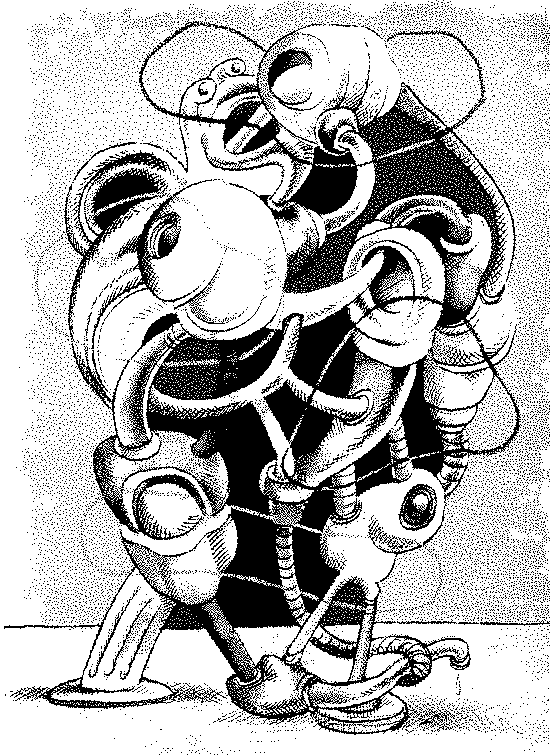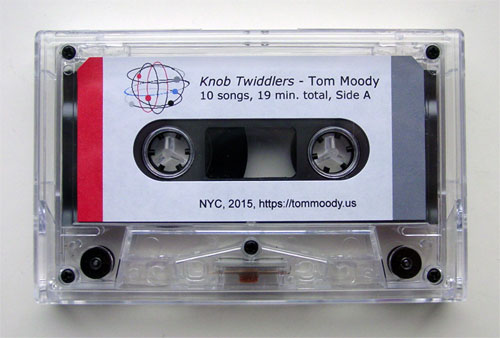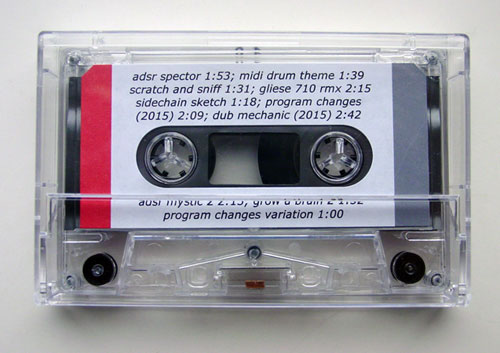
mixed media on paper; B&W dot conversion: online image editor
This story appeared in The Best Japanese Science Fiction Stories, edited by John L. Apostolou and Martin H. Greenberg (1989). The book is out of print and the text below is floating around the internet. Used without permission -- any objections, I'll remove it, but it's certainly a tale worth reading.
The typhoon had passed and the sky was a gorgeous blue. Even a certain village not far from the city had suffered damage. A little distance from the village and near the mountains, a small shrine had been swept away by a landslide.
"I wonder how long that shrine’s been here."
"Well, in any case, it must have been here since an awfully long time ago."
"We’ve got to rebuild it right away."
While the villagers exchanged views, several more of their number came over.
"It sure was wrecked."
"I think it used to be right here."
"No, looks like it was a little more over there."
Just then one of them raised his voice. "Hey what in the world is this hole?"
Where they had all gathered there was a hole about a meter in diameter. They peered in, but it was so dark nothing could be seen. However, it gave one the feeling that it was so deep it went clear through to the center of the earth.
There was even one person who said, "I wonder if it’s a fox’s hole."
"He—y, come on ou—t!" shouted a young man into the hole. There was no echo from the bottom. Next he picked up a pebble and was about to throw it in.
"You might bring down a curse on us. Lay off," warned an old man, but the younger one energetically threw the pebble in. As before, however, there was no answering response from the bottom. The villagers cut down some trees, tied them with rope and made a fence which they put around the hole. Then they repaired to the village.
"What do you suppose we ought to do?"
"Shouldn’t we build the shrine up just as it was over the hole?"
A day passed with no agreement. The news traveled fast, and a car from the newspaper company rushed over. In no time a scientist came out, and with an all-knowing expression on his face he went over to the hole. Next, a bunch of gawking curiosity seekers showed up; one could also pick out here and there men of shifty glances who appeared to be concessionaires. Concerned that someone might fall into the hole, a policeman from the local substation kept a careful watch.
One newspaper reporter tied a weight to the end of a long cord and lowered it into the hole. A long way down it went. The cord ran out, however, and he tried to pull it out, but it would not come back up. Two or three people helped out, but when they all pulled too hard, the cord parted at the edge of the hole. Another reporter, a camera in hand, who had been watching all of this, quietly untied a stout rope that had been wound around his waist.
The scientist contacted people at his laboratory and had them bring out a high-powered bull horn, with which he was going to check out the echo from the hole’s bottom. He tried switching through various sounds, but there was no echo. The scientist was puzzled, but he could not very well give up with everyone watching him so intently. He put the bull horn right up to the hole, turned it to its highest volume, and let it sound continuously for a long time. It was a noise that would have carried several dozen kilometers above ground. But the hole just calmly swallowed up the sound.
In his own mind the scientist was at a loss, but with a look of apparent composure he cut off the sound and, in a manner suggesting that the whole thing had a perfectly plausible explanation, said simply, "Fill it in."
Safer to get rid of something one didn’t understand.
The onlookers, disappointed that this was all that was going to happen, prepared to disperse. Just then one of the concessionaires, having broken through the throng and come forward, made a proposal.
"Let me have that hole. I’ll fill it in for you."
"We’d be grateful to you for filling it in," replied the mayor of the village, "but we can’t very well give you the hole. We have to build a shrine there."
"If it’s a shrine you want, I’ll build you a fine one later. Shall I make it with an attached meeting hall?"
Before the mayor could answer, the people of the village all shouted out.
"Really? Well, in that case, we ought to have it closer to the village."
"It’s just an old hole. We’ll give it to you!"
So it was settled. And the mayor, of course, had no objection.
The concessionaire was true to his promise. It was small, but closer to the village he did build for them a shrine with an attached meeting hall.
About the time the autumn festival was held at the new shrine, the hole-filling company established by the concessionaire hung out its small shingle at a shack near the hole.
The concessionaire had his cohorts mount a loud campaign in the city. "We’ve got a fabulously deep hole! Scientists say it’s at least five thousand meters deep! Perfect for the disposal of such things as waste from nuclear reactors."
Government authorities granted permission. Nuclear power plants fought for contracts. The people of the village were a bit worried about this, but they consented when it was explained that there would be absolutely no above-ground contamination for several thousand years and that they would share in the profits. Into the bargain, very shortly a magnificent road was built from the city to the village.
Trucks rolled in over the road, transporting lead boxes. Above the hole the lids were opened, and the wastes from nuclear reactors tumbled away into the hole.
From the Foreign Ministry and the Defense Agency boxes of unnecessary classified documents were brought for disposal. Officials who came to supervise the disposal held discussions on golf. The lesser functionaries, as they threw in the papers, chatted about pinball.
The hole showed no signs of filling up. It was awfully deep, thought some; or else it might be very spacious at the bottom. Little by little the hole-filling company expanded its business.
Bodies of animals used in contagious disease experiments at the universities were brought out, and to these were added the unclaimed corpses of vagrants. Better than dumping all of its garbage in the ocean, went the thinking in the city, and plans were made for a long pipe to carry it to the hole.
The hole gave peace of mind to the dwellers of the city. They concentrated solely on producing one thing after another. Everyone disliked thinking about the eventual consequences. People wanted only to work for production companies and sales corporations; they had no interest in becoming junk dealers. But, it was thought, these problems too would gradually be resolved by the hole.
Young girls whose betrothals had been arranged discarded old diaries in the hole. There were also those who were inaugurating new love affairs and threw into the hole old photographs of themselves taken with former sweethearts. The police felt comforted as they used the hole to get rid of accumulations of expertly done counterfeit bills. Criminals breathed easier after throwing material evidence into the hole.
Whatever one wished to discard, the hole accepted it all. The hole cleansed the city of its filth; the sea and sky seemed to have become a bit clearer than before.
Aiming at the heavens, new buildings went on being constructed one after the other.
One day, atop the high steel frame of a new building under construction, a workman was taking a break. Above his head he heard a voice shout:
"He—y, come on ou—t!"
But, in the sky to which he lifted his gaze there was nothing at all. A clear blue sky merely spread over all. He thought it must be his imagination. Then, as he resumed his former position, from the direction where the voice had come, a small pebble skimmed by him and fell on past.
The man, however, was gazing in idle reverie at the city’s skyline growing ever more beautiful, and he failed to notice.
This is the 8th track on the Knob Twiddlers release.
A cassette version of the release is also now available:


Skimming through some reviews of Maps to the Stars, it's exhausting watching reviewers such as the AV Club's A. A. Dowd as they attempt to weave in references to David Cronenberg's early movies to explain Maps as a "Cronenberg film." Cronenberg has said in interviews that he no longer makes Cronenberg films (such as They Came from Within, Scanners, or Videodrome). Mostly what he has done since the late '80s is adapt writers for the screen. ExistenZ was a brief return to form but even it was almost self-parody.
Auteur-theory-wise, Maps is a Bruce Wagner movie, just as Eastern Promises was a Steven Knight movie and A History of Violence was a John Wagner movie. In each case Cronenberg provides a set of eyes and hands to implement the writers' visions. There is a clean, chilly style but very little authorial mind at work on the director's side. Casting, framing of shots, and working with actors is functional, at best. Workmanlike. The spark lies in the spoken dialogue, the story construction, and individual actors' performances: how the actors respond to Wagner's material.
Update, 2021: On a second, later viewing of this movie I've changed my mind about Cronenberg's influence on the film. It may not be "a Cronenberg film" as that term was formerly used but it is a horror film. See my comment here.